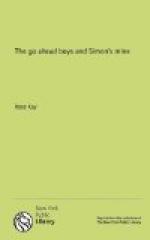Both George and Grant at once united in declaring that the decision which their friends already had made to seek for the lost mine was to be highly commended. Again and again the diary was inspected and the part wherein Simon Moultrie had recorded his discovery of the great lead was read aloud again and again.
Pete, the guide, a silent, bronzed man of thirty, openly scoffed at the idea that any discovery worth while would follow their attempts to find the spot indicated in the diary of the lost prospector.
“Nobody knows,” declared Pete, “whether you found the bones of Simon Moultrie or not.”
“That doesn’t make any difference,” declared Fred sturdily, “if we can only find the place he spoke of. Zeke says he knows where Thorn’s Gulch is—”
“Huh!” interrupted Pete. “I guess ev’rybody in this part o’ th’ country knows where Thorn’s Gulch is.”
“But,” continued Fred, winking at John as he spoke, “he doesn’t know where Two Crow Tree is nor just where Tom’s Thumb is located. Of course you know, so we came back to the camp.”
“If I don’t know I can find ’em, I guess,” assented Pete sturdily.
“That’s just what Zeke said,” laughed Fred. “What we’re looking for isn’t somebody who can find them, but somebody who knows where they are.”
“Don’t you worry none about that,” said Pete. “We’ll find the spot if there’s any such place.”
The camp was located in a most attractive spot, high above the roaring river. It was on the sloping side of the towering border. A natural pathway lead to the plateau above, while a spring of clear water was conveniently near for their needs.
In spite of the July day the air was cool and the smoke of their camp-fire was carried swiftly down the canyon. The sublime sight of the Grand Canyon was before them, although from their camp they were unable to see the largest of all the great gulches.
The sides of the various canyons, which the swiftly flowing Colorado had made, were carved and fretted almost beyond belief. The various strata of rock and soil that had been exposed to view by the centuries of action of the mighty river were marvelously tinted. Indeed, George declared that the blues, the grays, and reds and mauves were only less impressive than the overwhelming size of the Grand Canyon itself. Grant, however, was positive that the sculptured sides of the vast hole were equal in interest to the coloring and the glory of the canyon itself.
With every changing angle of the sun the colors and shadings also changed. Again and again the boys had marked the shadows formed every morning and evening and they laughingly announced and described the various resemblances which they had traced.
The Grand Canyon itself is only a part of the long canyon, in places a mile deep and in certain places a score of miles from side to side, through which the mighty river has forced its way.




